Forsyth House Building: Design, Science, and Material Analysis
VerifiedAdded on 2023/06/04
|12
|3907
|281
Report
AI Summary
This report provides a detailed analysis of the Forsyth House in London, focusing on building design and building science principles. It begins with an introduction to building science and construction, highlighting the rapid growth in the construction industry due to improved technologies and designs. The report then delves into the specifics of Forsyth House, including its address, construction date (completed in 1970), and purpose. It examines the structural elements such as the foundation, roof, parapets, beams, slabs, columns, walls, floors, and stairs, discussing their roles and materials. The report also covers non-structural elements, like flooring, tiling, carpets, and windows, emphasizing their importance and maintenance requirements. The analysis considers the building's design in the context of the 1960s, noting the impact of changing climatic conditions on materials like wood. The report concludes by summarizing the key findings related to the building's design, structural integrity, and material choices.
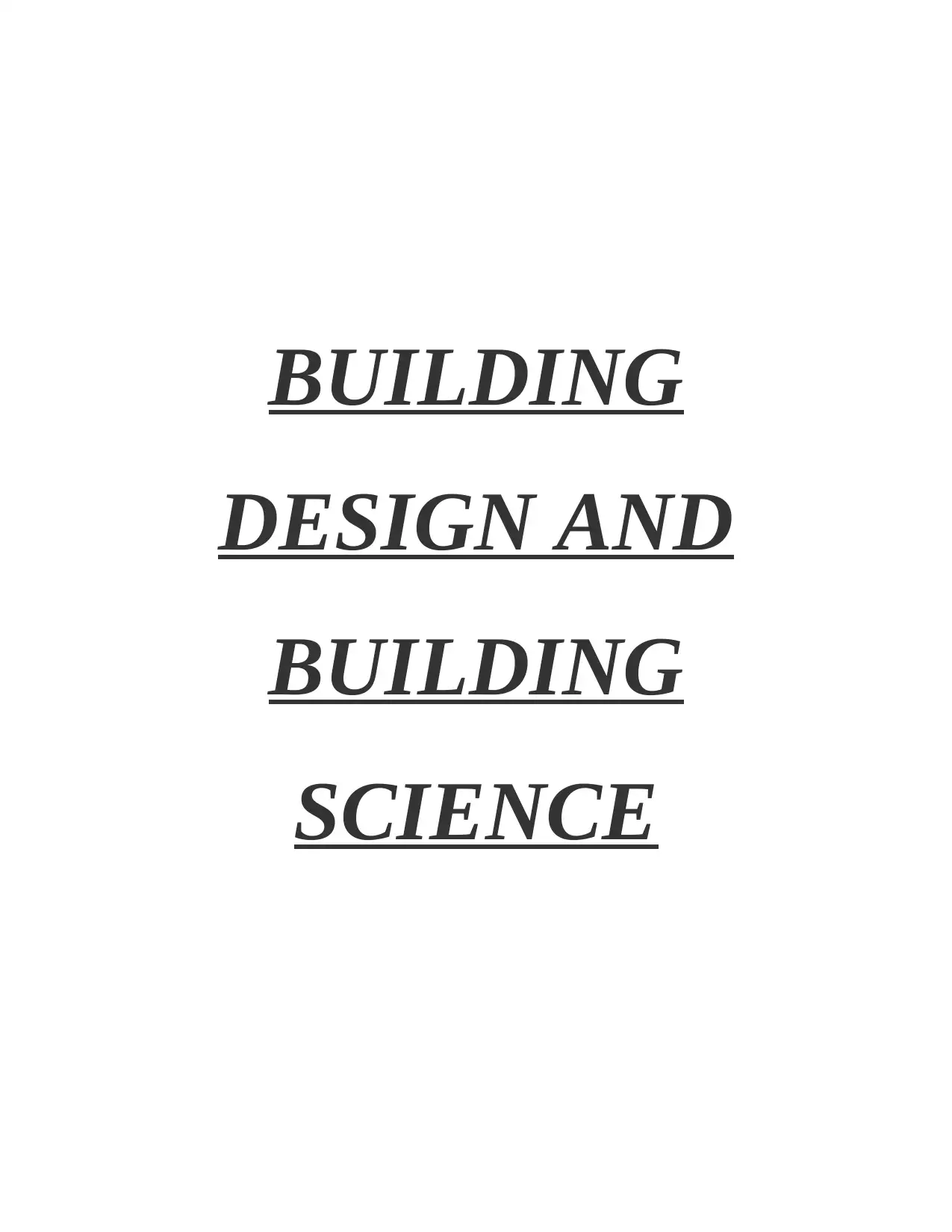
BUILDING
DESIGN AND
BUILDING
SCIENCE
DESIGN AND
BUILDING
SCIENCE
Paraphrase This Document
Need a fresh take? Get an instant paraphrase of this document with our AI Paraphraser
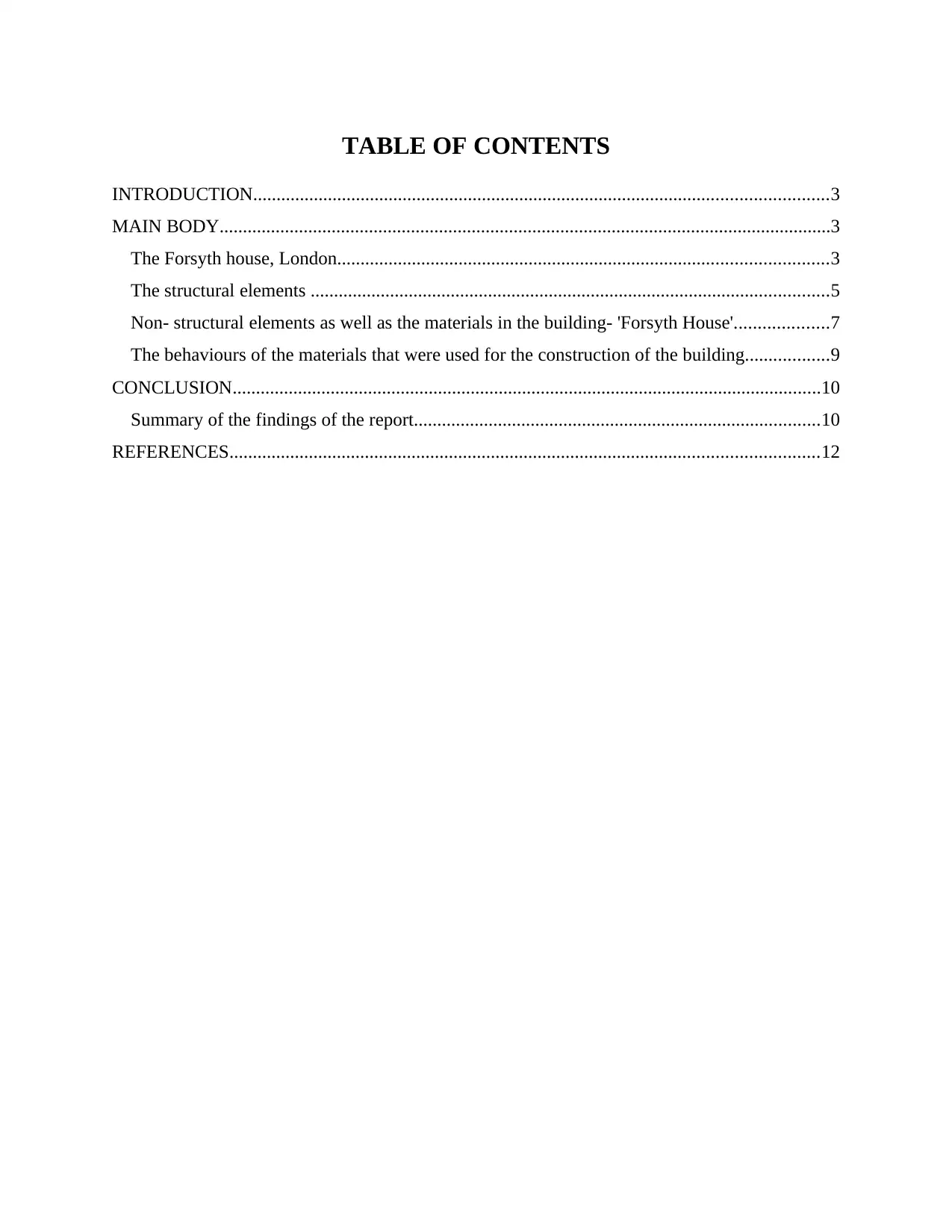
TABLE OF CONTENTS
INTRODUCTION...........................................................................................................................3
MAIN BODY...................................................................................................................................3
The Forsyth house, London.........................................................................................................3
The structural elements ...............................................................................................................5
Non- structural elements as well as the materials in the building- 'Forsyth House'....................7
The behaviours of the materials that were used for the construction of the building..................9
CONCLUSION..............................................................................................................................10
Summary of the findings of the report.......................................................................................10
REFERENCES..............................................................................................................................12
INTRODUCTION...........................................................................................................................3
MAIN BODY...................................................................................................................................3
The Forsyth house, London.........................................................................................................3
The structural elements ...............................................................................................................5
Non- structural elements as well as the materials in the building- 'Forsyth House'....................7
The behaviours of the materials that were used for the construction of the building..................9
CONCLUSION..............................................................................................................................10
Summary of the findings of the report.......................................................................................10
REFERENCES..............................................................................................................................12
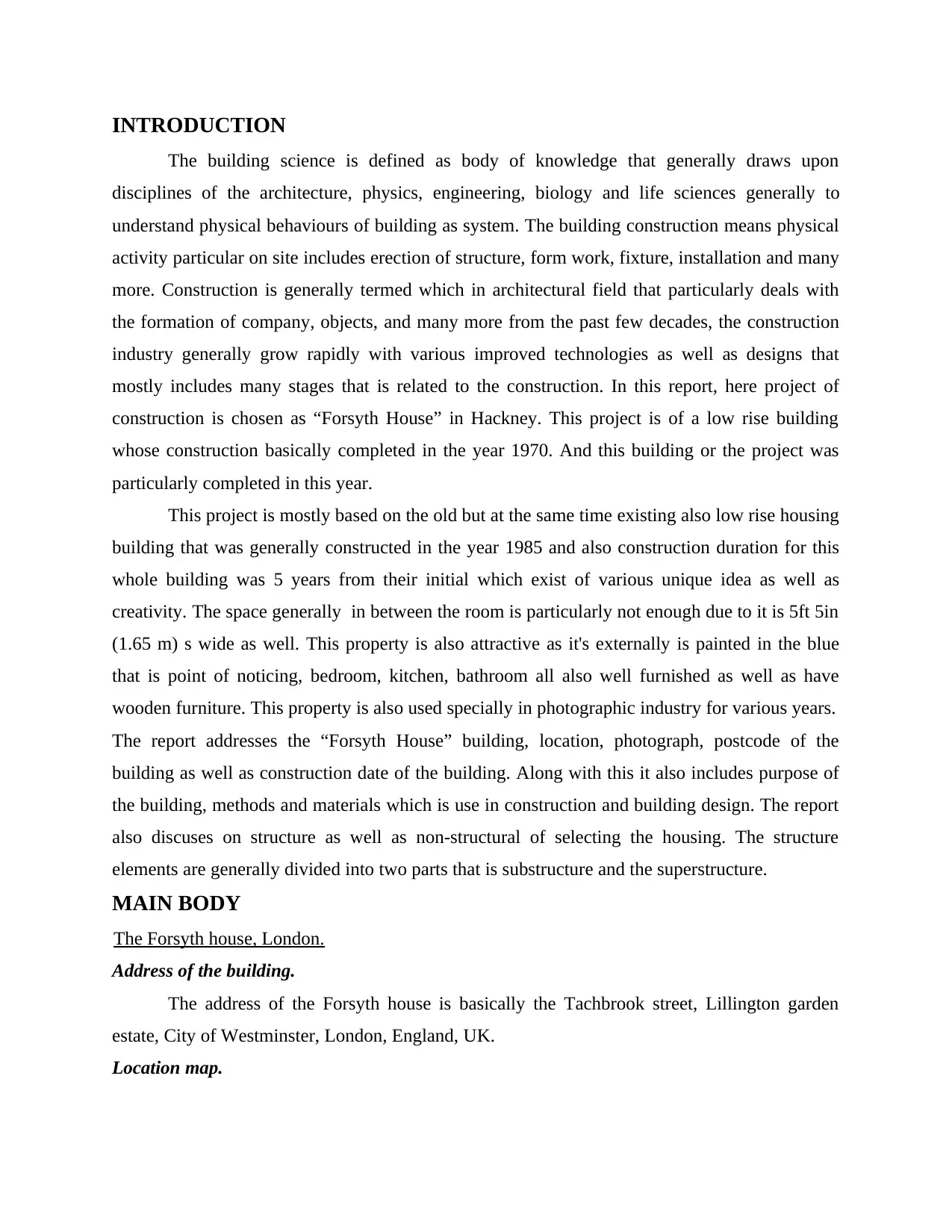
INTRODUCTION
The building science is defined as body of knowledge that generally draws upon
disciplines of the architecture, physics, engineering, biology and life sciences generally to
understand physical behaviours of building as system. The building construction means physical
activity particular on site includes erection of structure, form work, fixture, installation and many
more. Construction is generally termed which in architectural field that particularly deals with
the formation of company, objects, and many more from the past few decades, the construction
industry generally grow rapidly with various improved technologies as well as designs that
mostly includes many stages that is related to the construction. In this report, here project of
construction is chosen as “Forsyth House” in Hackney. This project is of a low rise building
whose construction basically completed in the year 1970. And this building or the project was
particularly completed in this year.
This project is mostly based on the old but at the same time existing also low rise housing
building that was generally constructed in the year 1985 and also construction duration for this
whole building was 5 years from their initial which exist of various unique idea as well as
creativity. The space generally in between the room is particularly not enough due to it is 5ft 5in
(1.65 m) s wide as well. This property is also attractive as it's externally is painted in the blue
that is point of noticing, bedroom, kitchen, bathroom all also well furnished as well as have
wooden furniture. This property is also used specially in photographic industry for various years.
The report addresses the “Forsyth House” building, location, photograph, postcode of the
building as well as construction date of the building. Along with this it also includes purpose of
the building, methods and materials which is use in construction and building design. The report
also discuses on structure as well as non-structural of selecting the housing. The structure
elements are generally divided into two parts that is substructure and the superstructure.
MAIN BODY
The Forsyth house, London.
Address of the building.
The address of the Forsyth house is basically the Tachbrook street, Lillington garden
estate, City of Westminster, London, England, UK.
Location map.
The building science is defined as body of knowledge that generally draws upon
disciplines of the architecture, physics, engineering, biology and life sciences generally to
understand physical behaviours of building as system. The building construction means physical
activity particular on site includes erection of structure, form work, fixture, installation and many
more. Construction is generally termed which in architectural field that particularly deals with
the formation of company, objects, and many more from the past few decades, the construction
industry generally grow rapidly with various improved technologies as well as designs that
mostly includes many stages that is related to the construction. In this report, here project of
construction is chosen as “Forsyth House” in Hackney. This project is of a low rise building
whose construction basically completed in the year 1970. And this building or the project was
particularly completed in this year.
This project is mostly based on the old but at the same time existing also low rise housing
building that was generally constructed in the year 1985 and also construction duration for this
whole building was 5 years from their initial which exist of various unique idea as well as
creativity. The space generally in between the room is particularly not enough due to it is 5ft 5in
(1.65 m) s wide as well. This property is also attractive as it's externally is painted in the blue
that is point of noticing, bedroom, kitchen, bathroom all also well furnished as well as have
wooden furniture. This property is also used specially in photographic industry for various years.
The report addresses the “Forsyth House” building, location, photograph, postcode of the
building as well as construction date of the building. Along with this it also includes purpose of
the building, methods and materials which is use in construction and building design. The report
also discuses on structure as well as non-structural of selecting the housing. The structure
elements are generally divided into two parts that is substructure and the superstructure.
MAIN BODY
The Forsyth house, London.
Address of the building.
The address of the Forsyth house is basically the Tachbrook street, Lillington garden
estate, City of Westminster, London, England, UK.
Location map.
⊘ This is a preview!⊘
Do you want full access?
Subscribe today to unlock all pages.

Trusted by 1+ million students worldwide
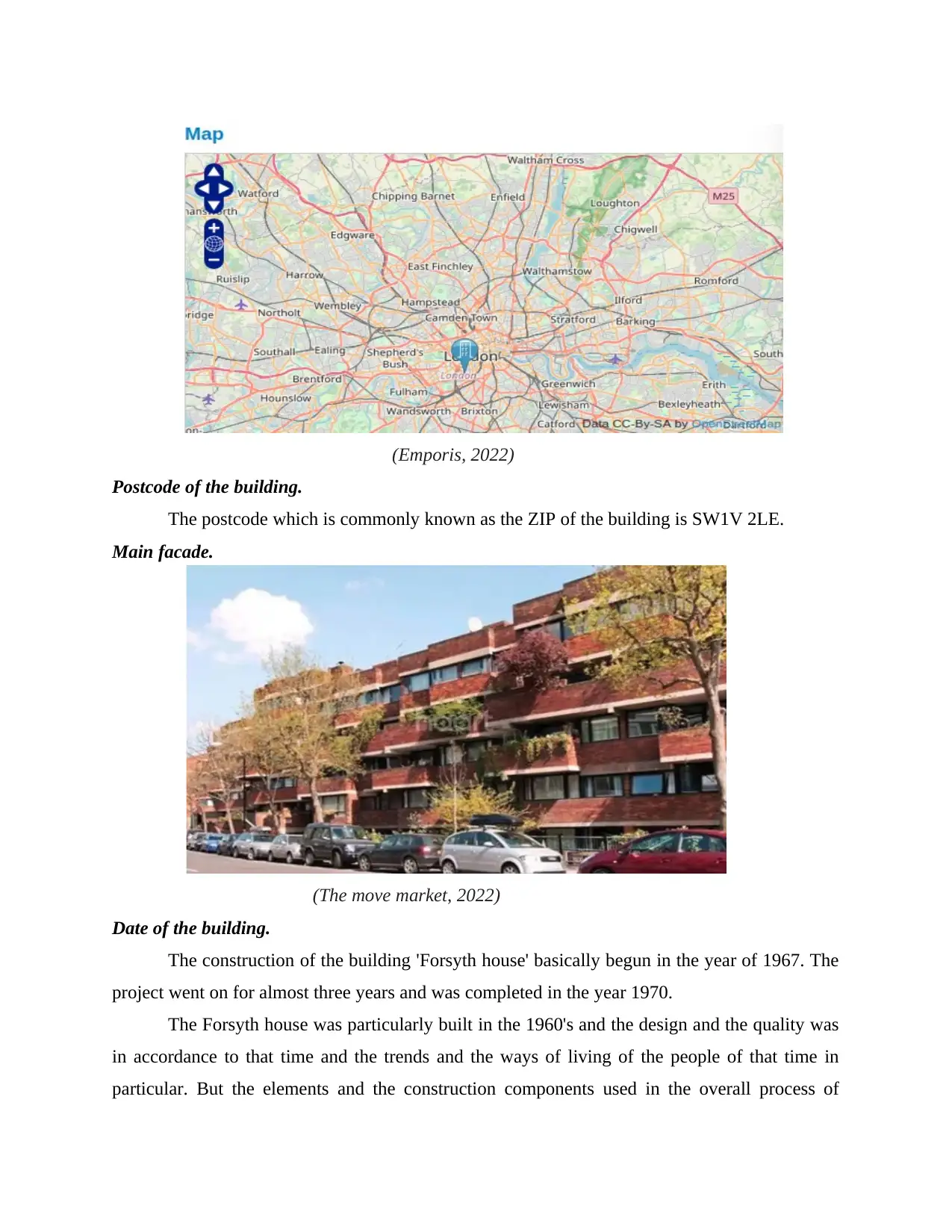
(Emporis, 2022)
Postcode of the building.
The postcode which is commonly known as the ZIP of the building is SW1V 2LE.
Main facade.
(The move market, 2022)
Date of the building.
The construction of the building 'Forsyth house' basically begun in the year of 1967. The
project went on for almost three years and was completed in the year 1970.
The Forsyth house was particularly built in the 1960's and the design and the quality was
in accordance to that time and the trends and the ways of living of the people of that time in
particular. But the elements and the construction components used in the overall process of
Postcode of the building.
The postcode which is commonly known as the ZIP of the building is SW1V 2LE.
Main facade.
(The move market, 2022)
Date of the building.
The construction of the building 'Forsyth house' basically begun in the year of 1967. The
project went on for almost three years and was completed in the year 1970.
The Forsyth house was particularly built in the 1960's and the design and the quality was
in accordance to that time and the trends and the ways of living of the people of that time in
particular. But the elements and the construction components used in the overall process of
Paraphrase This Document
Need a fresh take? Get an instant paraphrase of this document with our AI Paraphraser
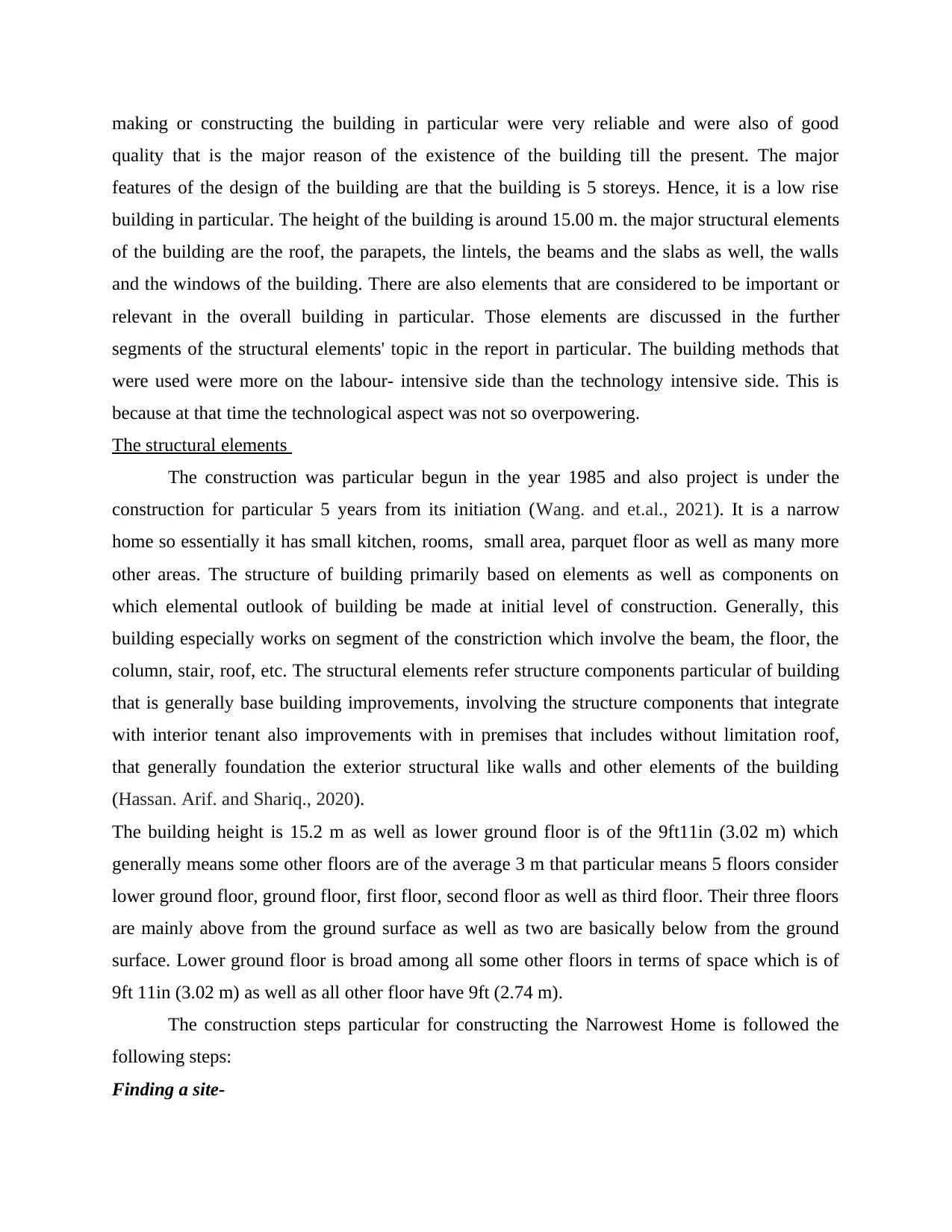
making or constructing the building in particular were very reliable and were also of good
quality that is the major reason of the existence of the building till the present. The major
features of the design of the building are that the building is 5 storeys. Hence, it is a low rise
building in particular. The height of the building is around 15.00 m. the major structural elements
of the building are the roof, the parapets, the lintels, the beams and the slabs as well, the walls
and the windows of the building. There are also elements that are considered to be important or
relevant in the overall building in particular. Those elements are discussed in the further
segments of the structural elements' topic in the report in particular. The building methods that
were used were more on the labour- intensive side than the technology intensive side. This is
because at that time the technological aspect was not so overpowering.
The structural elements
The construction was particular begun in the year 1985 and also project is under the
construction for particular 5 years from its initiation (Wang. and et.al., 2021). It is a narrow
home so essentially it has small kitchen, rooms, small area, parquet floor as well as many more
other areas. The structure of building primarily based on elements as well as components on
which elemental outlook of building be made at initial level of construction. Generally, this
building especially works on segment of the constriction which involve the beam, the floor, the
column, stair, roof, etc. The structural elements refer structure components particular of building
that is generally base building improvements, involving the structure components that integrate
with interior tenant also improvements with in premises that includes without limitation roof,
that generally foundation the exterior structural like walls and other elements of the building
(Hassan. Arif. and Shariq., 2020).
The building height is 15.2 m as well as lower ground floor is of the 9ft11in (3.02 m) which
generally means some other floors are of the average 3 m that particular means 5 floors consider
lower ground floor, ground floor, first floor, second floor as well as third floor. Their three floors
are mainly above from the ground surface as well as two are basically below from the ground
surface. Lower ground floor is broad among all some other floors in terms of space which is of
9ft 11in (3.02 m) as well as all other floor have 9ft (2.74 m).
The construction steps particular for constructing the Narrowest Home is followed the
following steps:
Finding a site-
quality that is the major reason of the existence of the building till the present. The major
features of the design of the building are that the building is 5 storeys. Hence, it is a low rise
building in particular. The height of the building is around 15.00 m. the major structural elements
of the building are the roof, the parapets, the lintels, the beams and the slabs as well, the walls
and the windows of the building. There are also elements that are considered to be important or
relevant in the overall building in particular. Those elements are discussed in the further
segments of the structural elements' topic in the report in particular. The building methods that
were used were more on the labour- intensive side than the technology intensive side. This is
because at that time the technological aspect was not so overpowering.
The structural elements
The construction was particular begun in the year 1985 and also project is under the
construction for particular 5 years from its initiation (Wang. and et.al., 2021). It is a narrow
home so essentially it has small kitchen, rooms, small area, parquet floor as well as many more
other areas. The structure of building primarily based on elements as well as components on
which elemental outlook of building be made at initial level of construction. Generally, this
building especially works on segment of the constriction which involve the beam, the floor, the
column, stair, roof, etc. The structural elements refer structure components particular of building
that is generally base building improvements, involving the structure components that integrate
with interior tenant also improvements with in premises that includes without limitation roof,
that generally foundation the exterior structural like walls and other elements of the building
(Hassan. Arif. and Shariq., 2020).
The building height is 15.2 m as well as lower ground floor is of the 9ft11in (3.02 m) which
generally means some other floors are of the average 3 m that particular means 5 floors consider
lower ground floor, ground floor, first floor, second floor as well as third floor. Their three floors
are mainly above from the ground surface as well as two are basically below from the ground
surface. Lower ground floor is broad among all some other floors in terms of space which is of
9ft 11in (3.02 m) as well as all other floor have 9ft (2.74 m).
The construction steps particular for constructing the Narrowest Home is followed the
following steps:
Finding a site-
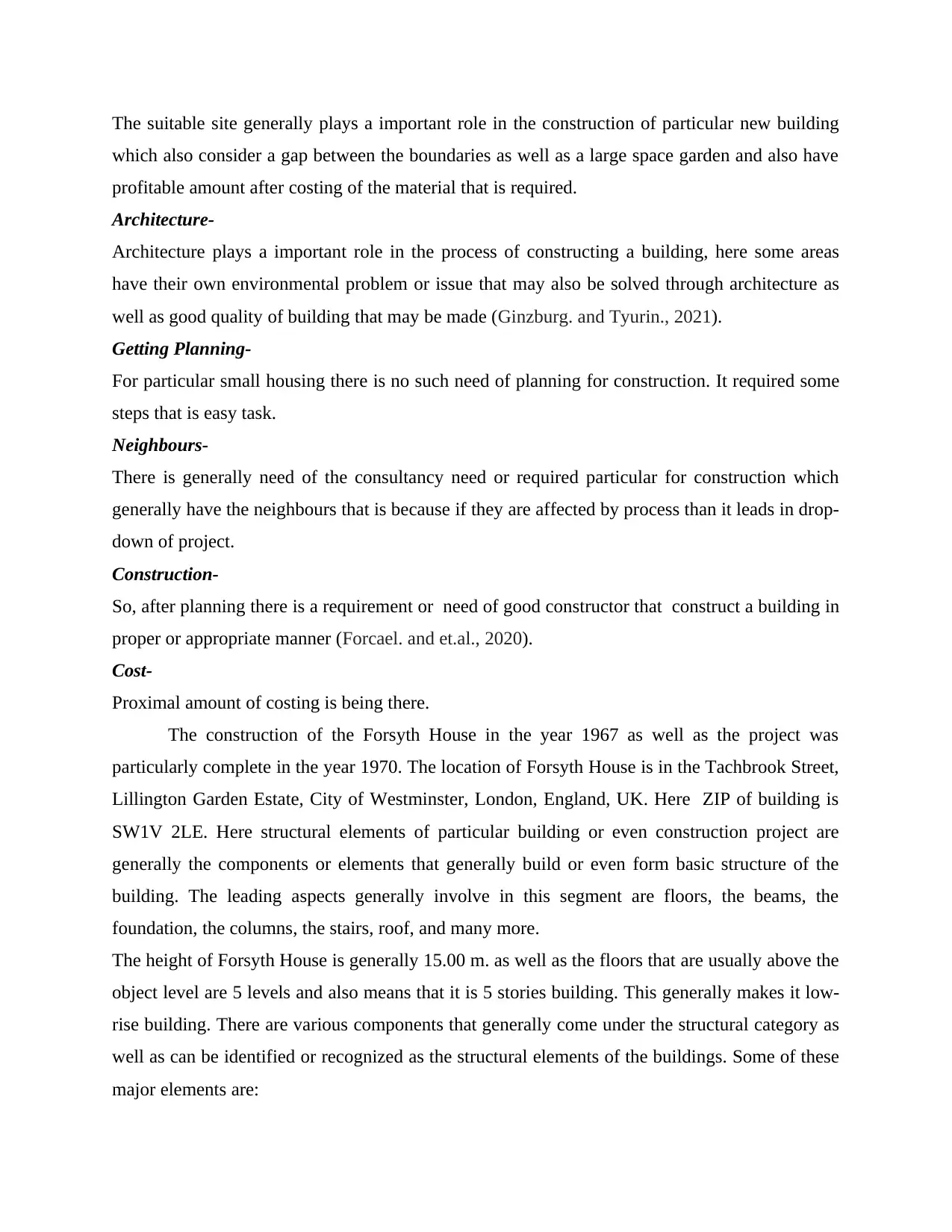
The suitable site generally plays a important role in the construction of particular new building
which also consider a gap between the boundaries as well as a large space garden and also have
profitable amount after costing of the material that is required.
Architecture-
Architecture plays a important role in the process of constructing a building, here some areas
have their own environmental problem or issue that may also be solved through architecture as
well as good quality of building that may be made (Ginzburg. and Tyurin., 2021).
Getting Planning-
For particular small housing there is no such need of planning for construction. It required some
steps that is easy task.
Neighbours-
There is generally need of the consultancy need or required particular for construction which
generally have the neighbours that is because if they are affected by process than it leads in drop-
down of project.
Construction-
So, after planning there is a requirement or need of good constructor that construct a building in
proper or appropriate manner (Forcael. and et.al., 2020).
Cost-
Proximal amount of costing is being there.
The construction of the Forsyth House in the year 1967 as well as the project was
particularly complete in the year 1970. The location of Forsyth House is in the Tachbrook Street,
Lillington Garden Estate, City of Westminster, London, England, UK. Here ZIP of building is
SW1V 2LE. Here structural elements of particular building or even construction project are
generally the components or elements that generally build or even form basic structure of the
building. The leading aspects generally involve in this segment are floors, the beams, the
foundation, the columns, the stairs, roof, and many more.
The height of Forsyth House is generally 15.00 m. as well as the floors that are usually above the
object level are 5 levels and also means that it is 5 stories building. This generally makes it low-
rise building. There are various components that generally come under the structural category as
well as can be identified or recognized as the structural elements of the buildings. Some of these
major elements are:
which also consider a gap between the boundaries as well as a large space garden and also have
profitable amount after costing of the material that is required.
Architecture-
Architecture plays a important role in the process of constructing a building, here some areas
have their own environmental problem or issue that may also be solved through architecture as
well as good quality of building that may be made (Ginzburg. and Tyurin., 2021).
Getting Planning-
For particular small housing there is no such need of planning for construction. It required some
steps that is easy task.
Neighbours-
There is generally need of the consultancy need or required particular for construction which
generally have the neighbours that is because if they are affected by process than it leads in drop-
down of project.
Construction-
So, after planning there is a requirement or need of good constructor that construct a building in
proper or appropriate manner (Forcael. and et.al., 2020).
Cost-
Proximal amount of costing is being there.
The construction of the Forsyth House in the year 1967 as well as the project was
particularly complete in the year 1970. The location of Forsyth House is in the Tachbrook Street,
Lillington Garden Estate, City of Westminster, London, England, UK. Here ZIP of building is
SW1V 2LE. Here structural elements of particular building or even construction project are
generally the components or elements that generally build or even form basic structure of the
building. The leading aspects generally involve in this segment are floors, the beams, the
foundation, the columns, the stairs, roof, and many more.
The height of Forsyth House is generally 15.00 m. as well as the floors that are usually above the
object level are 5 levels and also means that it is 5 stories building. This generally makes it low-
rise building. There are various components that generally come under the structural category as
well as can be identified or recognized as the structural elements of the buildings. Some of these
major elements are:
⊘ This is a preview!⊘
Do you want full access?
Subscribe today to unlock all pages.

Trusted by 1+ million students worldwide
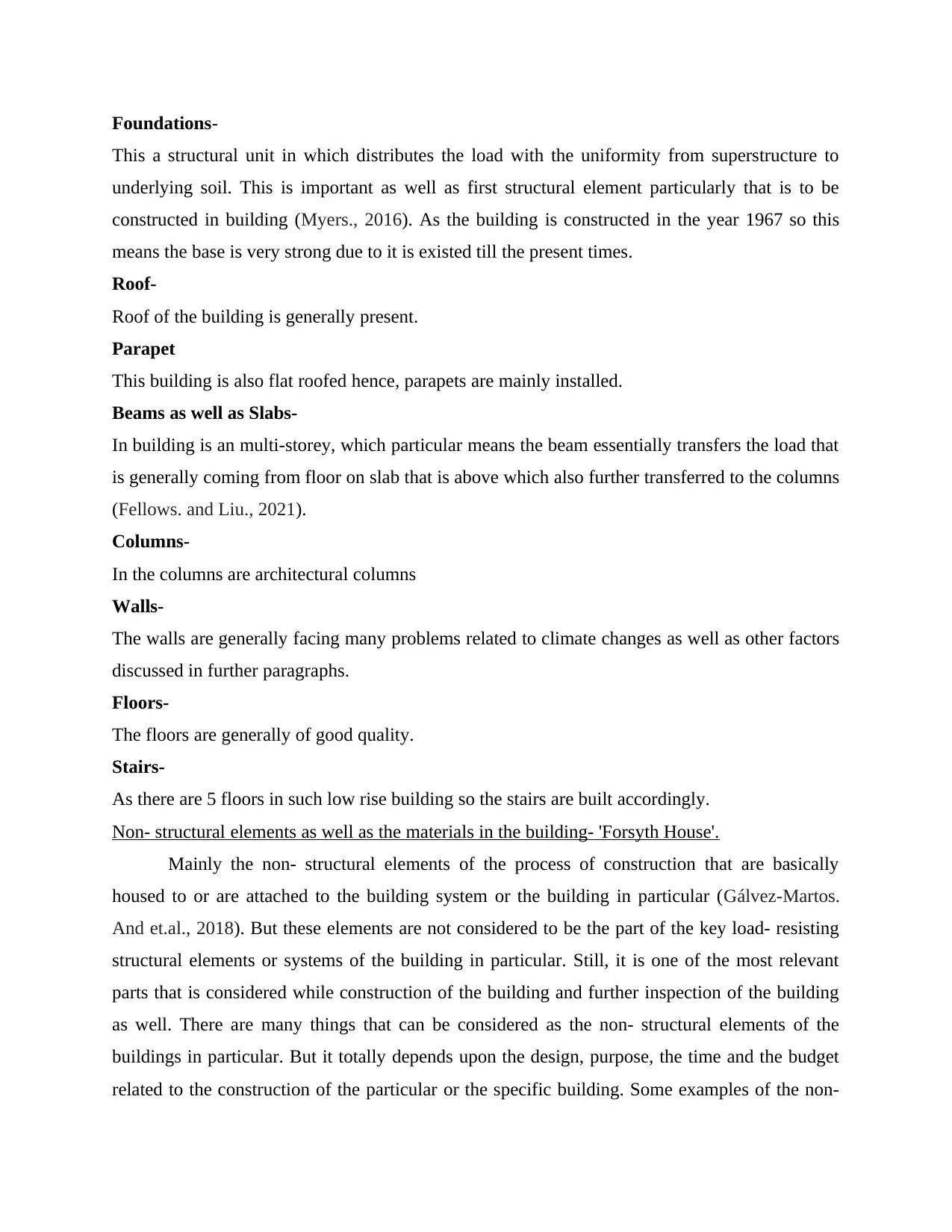
Foundations-
This a structural unit in which distributes the load with the uniformity from superstructure to
underlying soil. This is important as well as first structural element particularly that is to be
constructed in building (Myers., 2016). As the building is constructed in the year 1967 so this
means the base is very strong due to it is existed till the present times.
Roof-
Roof of the building is generally present.
Parapet
This building is also flat roofed hence, parapets are mainly installed.
Beams as well as Slabs-
In building is an multi-storey, which particular means the beam essentially transfers the load that
is generally coming from floor on slab that is above which also further transferred to the columns
(Fellows. and Liu., 2021).
Columns-
In the columns are architectural columns
Walls-
The walls are generally facing many problems related to climate changes as well as other factors
discussed in further paragraphs.
Floors-
The floors are generally of good quality.
Stairs-
As there are 5 floors in such low rise building so the stairs are built accordingly.
Non- structural elements as well as the materials in the building- 'Forsyth House'.
Mainly the non- structural elements of the process of construction that are basically
housed to or are attached to the building system or the building in particular (Gálvez-Martos.
And et.al., 2018). But these elements are not considered to be the part of the key load- resisting
structural elements or systems of the building in particular. Still, it is one of the most relevant
parts that is considered while construction of the building and further inspection of the building
as well. There are many things that can be considered as the non- structural elements of the
buildings in particular. But it totally depends upon the design, purpose, the time and the budget
related to the construction of the particular or the specific building. Some examples of the non-
This a structural unit in which distributes the load with the uniformity from superstructure to
underlying soil. This is important as well as first structural element particularly that is to be
constructed in building (Myers., 2016). As the building is constructed in the year 1967 so this
means the base is very strong due to it is existed till the present times.
Roof-
Roof of the building is generally present.
Parapet
This building is also flat roofed hence, parapets are mainly installed.
Beams as well as Slabs-
In building is an multi-storey, which particular means the beam essentially transfers the load that
is generally coming from floor on slab that is above which also further transferred to the columns
(Fellows. and Liu., 2021).
Columns-
In the columns are architectural columns
Walls-
The walls are generally facing many problems related to climate changes as well as other factors
discussed in further paragraphs.
Floors-
The floors are generally of good quality.
Stairs-
As there are 5 floors in such low rise building so the stairs are built accordingly.
Non- structural elements as well as the materials in the building- 'Forsyth House'.
Mainly the non- structural elements of the process of construction that are basically
housed to or are attached to the building system or the building in particular (Gálvez-Martos.
And et.al., 2018). But these elements are not considered to be the part of the key load- resisting
structural elements or systems of the building in particular. Still, it is one of the most relevant
parts that is considered while construction of the building and further inspection of the building
as well. There are many things that can be considered as the non- structural elements of the
buildings in particular. But it totally depends upon the design, purpose, the time and the budget
related to the construction of the particular or the specific building. Some examples of the non-
Paraphrase This Document
Need a fresh take? Get an instant paraphrase of this document with our AI Paraphraser
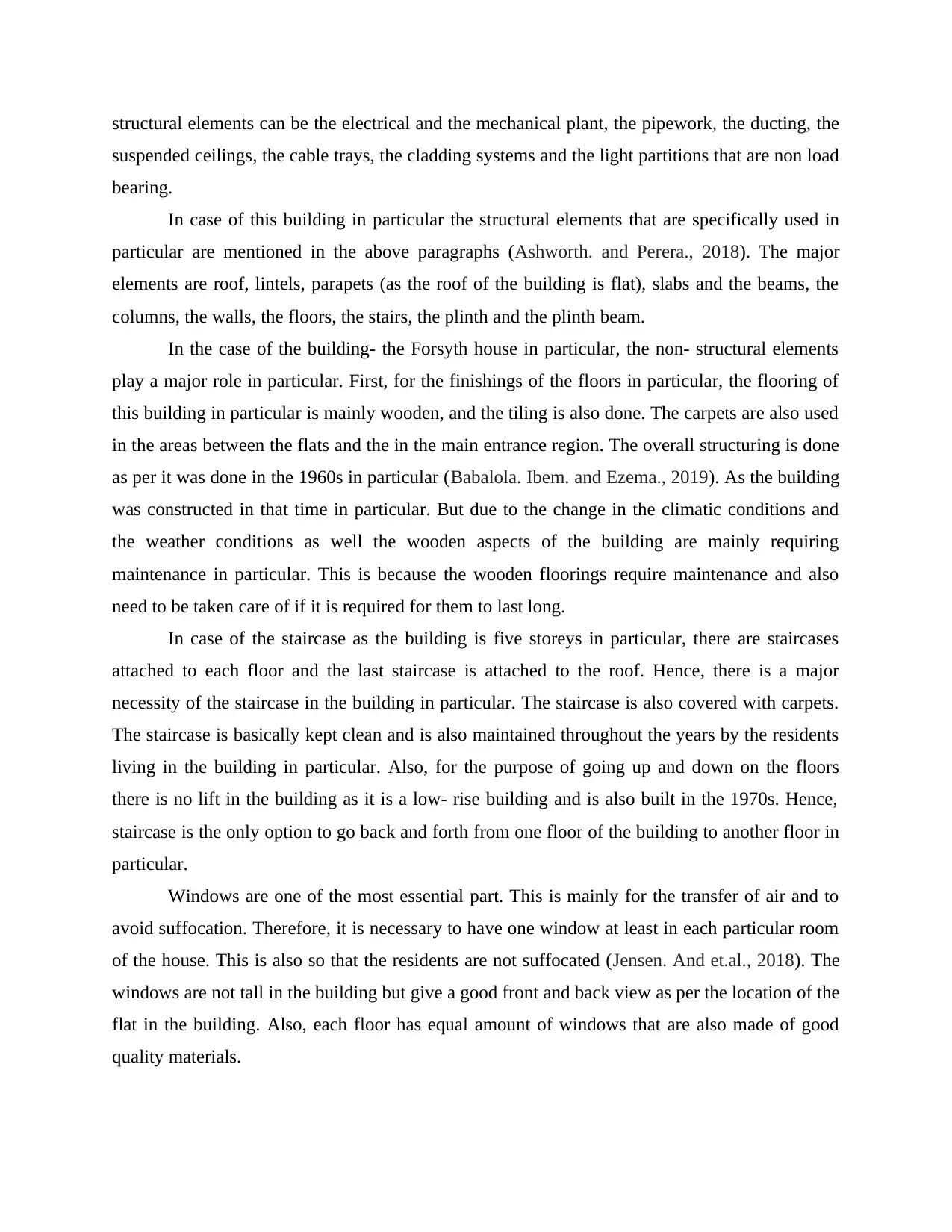
structural elements can be the electrical and the mechanical plant, the pipework, the ducting, the
suspended ceilings, the cable trays, the cladding systems and the light partitions that are non load
bearing.
In case of this building in particular the structural elements that are specifically used in
particular are mentioned in the above paragraphs (Ashworth. and Perera., 2018). The major
elements are roof, lintels, parapets (as the roof of the building is flat), slabs and the beams, the
columns, the walls, the floors, the stairs, the plinth and the plinth beam.
In the case of the building- the Forsyth house in particular, the non- structural elements
play a major role in particular. First, for the finishings of the floors in particular, the flooring of
this building in particular is mainly wooden, and the tiling is also done. The carpets are also used
in the areas between the flats and the in the main entrance region. The overall structuring is done
as per it was done in the 1960s in particular (Babalola. Ibem. and Ezema., 2019). As the building
was constructed in that time in particular. But due to the change in the climatic conditions and
the weather conditions as well the wooden aspects of the building are mainly requiring
maintenance in particular. This is because the wooden floorings require maintenance and also
need to be taken care of if it is required for them to last long.
In case of the staircase as the building is five storeys in particular, there are staircases
attached to each floor and the last staircase is attached to the roof. Hence, there is a major
necessity of the staircase in the building in particular. The staircase is also covered with carpets.
The staircase is basically kept clean and is also maintained throughout the years by the residents
living in the building in particular. Also, for the purpose of going up and down on the floors
there is no lift in the building as it is a low- rise building and is also built in the 1970s. Hence,
staircase is the only option to go back and forth from one floor of the building to another floor in
particular.
Windows are one of the most essential part. This is mainly for the transfer of air and to
avoid suffocation. Therefore, it is necessary to have one window at least in each particular room
of the house. This is also so that the residents are not suffocated (Jensen. And et.al., 2018). The
windows are not tall in the building but give a good front and back view as per the location of the
flat in the building. Also, each floor has equal amount of windows that are also made of good
quality materials.
suspended ceilings, the cable trays, the cladding systems and the light partitions that are non load
bearing.
In case of this building in particular the structural elements that are specifically used in
particular are mentioned in the above paragraphs (Ashworth. and Perera., 2018). The major
elements are roof, lintels, parapets (as the roof of the building is flat), slabs and the beams, the
columns, the walls, the floors, the stairs, the plinth and the plinth beam.
In the case of the building- the Forsyth house in particular, the non- structural elements
play a major role in particular. First, for the finishings of the floors in particular, the flooring of
this building in particular is mainly wooden, and the tiling is also done. The carpets are also used
in the areas between the flats and the in the main entrance region. The overall structuring is done
as per it was done in the 1960s in particular (Babalola. Ibem. and Ezema., 2019). As the building
was constructed in that time in particular. But due to the change in the climatic conditions and
the weather conditions as well the wooden aspects of the building are mainly requiring
maintenance in particular. This is because the wooden floorings require maintenance and also
need to be taken care of if it is required for them to last long.
In case of the staircase as the building is five storeys in particular, there are staircases
attached to each floor and the last staircase is attached to the roof. Hence, there is a major
necessity of the staircase in the building in particular. The staircase is also covered with carpets.
The staircase is basically kept clean and is also maintained throughout the years by the residents
living in the building in particular. Also, for the purpose of going up and down on the floors
there is no lift in the building as it is a low- rise building and is also built in the 1970s. Hence,
staircase is the only option to go back and forth from one floor of the building to another floor in
particular.
Windows are one of the most essential part. This is mainly for the transfer of air and to
avoid suffocation. Therefore, it is necessary to have one window at least in each particular room
of the house. This is also so that the residents are not suffocated (Jensen. And et.al., 2018). The
windows are not tall in the building but give a good front and back view as per the location of the
flat in the building. Also, each floor has equal amount of windows that are also made of good
quality materials.
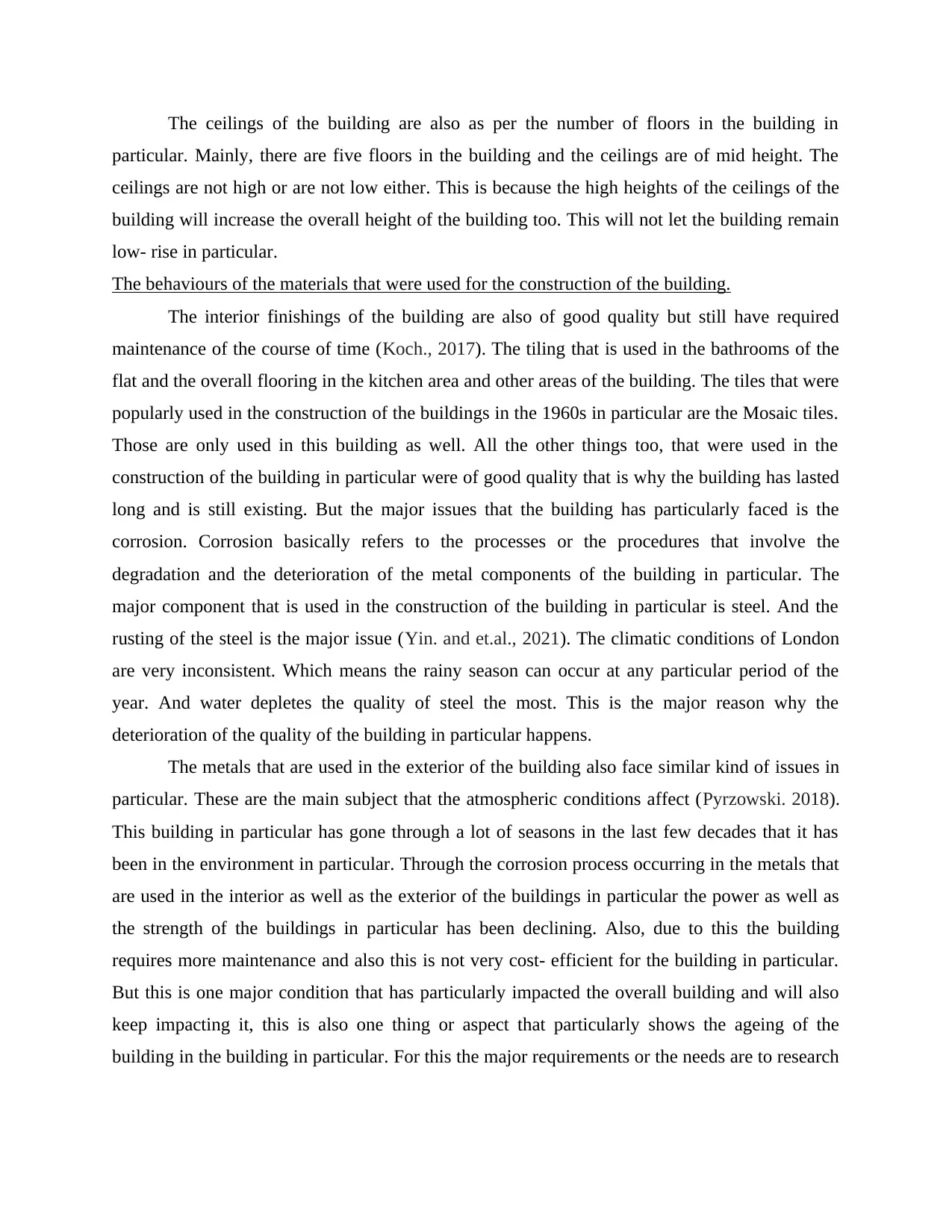
The ceilings of the building are also as per the number of floors in the building in
particular. Mainly, there are five floors in the building and the ceilings are of mid height. The
ceilings are not high or are not low either. This is because the high heights of the ceilings of the
building will increase the overall height of the building too. This will not let the building remain
low- rise in particular.
The behaviours of the materials that were used for the construction of the building.
The interior finishings of the building are also of good quality but still have required
maintenance of the course of time (Koch., 2017). The tiling that is used in the bathrooms of the
flat and the overall flooring in the kitchen area and other areas of the building. The tiles that were
popularly used in the construction of the buildings in the 1960s in particular are the Mosaic tiles.
Those are only used in this building as well. All the other things too, that were used in the
construction of the building in particular were of good quality that is why the building has lasted
long and is still existing. But the major issues that the building has particularly faced is the
corrosion. Corrosion basically refers to the processes or the procedures that involve the
degradation and the deterioration of the metal components of the building in particular. The
major component that is used in the construction of the building in particular is steel. And the
rusting of the steel is the major issue (Yin. and et.al., 2021). The climatic conditions of London
are very inconsistent. Which means the rainy season can occur at any particular period of the
year. And water depletes the quality of steel the most. This is the major reason why the
deterioration of the quality of the building in particular happens.
The metals that are used in the exterior of the building also face similar kind of issues in
particular. These are the main subject that the atmospheric conditions affect (Pyrzowski. 2018).
This building in particular has gone through a lot of seasons in the last few decades that it has
been in the environment in particular. Through the corrosion process occurring in the metals that
are used in the interior as well as the exterior of the buildings in particular the power as well as
the strength of the buildings in particular has been declining. Also, due to this the building
requires more maintenance and also this is not very cost- efficient for the building in particular.
But this is one major condition that has particularly impacted the overall building and will also
keep impacting it, this is also one thing or aspect that particularly shows the ageing of the
building in the building in particular. For this the major requirements or the needs are to research
particular. Mainly, there are five floors in the building and the ceilings are of mid height. The
ceilings are not high or are not low either. This is because the high heights of the ceilings of the
building will increase the overall height of the building too. This will not let the building remain
low- rise in particular.
The behaviours of the materials that were used for the construction of the building.
The interior finishings of the building are also of good quality but still have required
maintenance of the course of time (Koch., 2017). The tiling that is used in the bathrooms of the
flat and the overall flooring in the kitchen area and other areas of the building. The tiles that were
popularly used in the construction of the buildings in the 1960s in particular are the Mosaic tiles.
Those are only used in this building as well. All the other things too, that were used in the
construction of the building in particular were of good quality that is why the building has lasted
long and is still existing. But the major issues that the building has particularly faced is the
corrosion. Corrosion basically refers to the processes or the procedures that involve the
degradation and the deterioration of the metal components of the building in particular. The
major component that is used in the construction of the building in particular is steel. And the
rusting of the steel is the major issue (Yin. and et.al., 2021). The climatic conditions of London
are very inconsistent. Which means the rainy season can occur at any particular period of the
year. And water depletes the quality of steel the most. This is the major reason why the
deterioration of the quality of the building in particular happens.
The metals that are used in the exterior of the building also face similar kind of issues in
particular. These are the main subject that the atmospheric conditions affect (Pyrzowski. 2018).
This building in particular has gone through a lot of seasons in the last few decades that it has
been in the environment in particular. Through the corrosion process occurring in the metals that
are used in the interior as well as the exterior of the buildings in particular the power as well as
the strength of the buildings in particular has been declining. Also, due to this the building
requires more maintenance and also this is not very cost- efficient for the building in particular.
But this is one major condition that has particularly impacted the overall building and will also
keep impacting it, this is also one thing or aspect that particularly shows the ageing of the
building in the building in particular. For this the major requirements or the needs are to research
⊘ This is a preview!⊘
Do you want full access?
Subscribe today to unlock all pages.

Trusted by 1+ million students worldwide
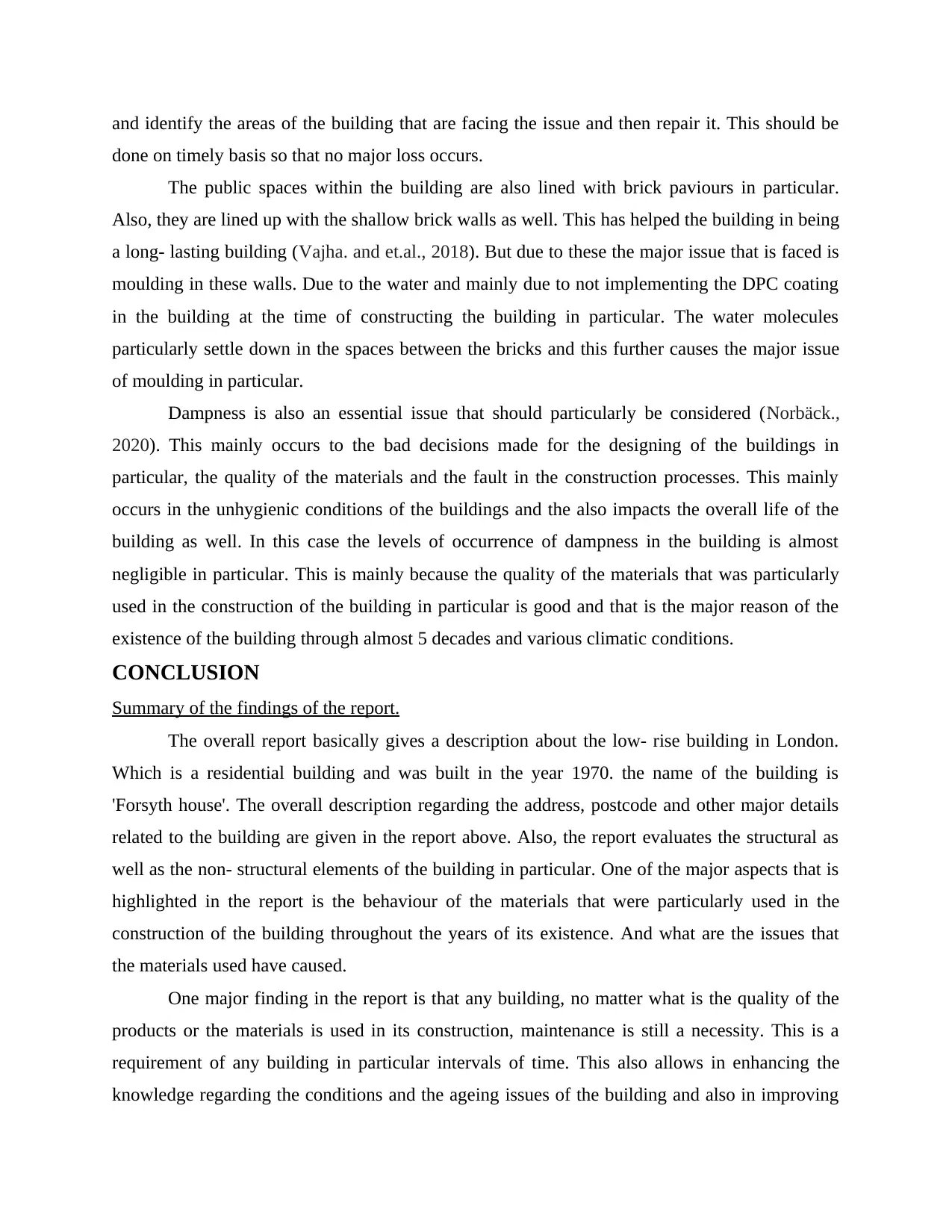
and identify the areas of the building that are facing the issue and then repair it. This should be
done on timely basis so that no major loss occurs.
The public spaces within the building are also lined with brick paviours in particular.
Also, they are lined up with the shallow brick walls as well. This has helped the building in being
a long- lasting building (Vajha. and et.al., 2018). But due to these the major issue that is faced is
moulding in these walls. Due to the water and mainly due to not implementing the DPC coating
in the building at the time of constructing the building in particular. The water molecules
particularly settle down in the spaces between the bricks and this further causes the major issue
of moulding in particular.
Dampness is also an essential issue that should particularly be considered (Norbäck.,
2020). This mainly occurs to the bad decisions made for the designing of the buildings in
particular, the quality of the materials and the fault in the construction processes. This mainly
occurs in the unhygienic conditions of the buildings and the also impacts the overall life of the
building as well. In this case the levels of occurrence of dampness in the building is almost
negligible in particular. This is mainly because the quality of the materials that was particularly
used in the construction of the building in particular is good and that is the major reason of the
existence of the building through almost 5 decades and various climatic conditions.
CONCLUSION
Summary of the findings of the report.
The overall report basically gives a description about the low- rise building in London.
Which is a residential building and was built in the year 1970. the name of the building is
'Forsyth house'. The overall description regarding the address, postcode and other major details
related to the building are given in the report above. Also, the report evaluates the structural as
well as the non- structural elements of the building in particular. One of the major aspects that is
highlighted in the report is the behaviour of the materials that were particularly used in the
construction of the building throughout the years of its existence. And what are the issues that
the materials used have caused.
One major finding in the report is that any building, no matter what is the quality of the
products or the materials is used in its construction, maintenance is still a necessity. This is a
requirement of any building in particular intervals of time. This also allows in enhancing the
knowledge regarding the conditions and the ageing issues of the building and also in improving
done on timely basis so that no major loss occurs.
The public spaces within the building are also lined with brick paviours in particular.
Also, they are lined up with the shallow brick walls as well. This has helped the building in being
a long- lasting building (Vajha. and et.al., 2018). But due to these the major issue that is faced is
moulding in these walls. Due to the water and mainly due to not implementing the DPC coating
in the building at the time of constructing the building in particular. The water molecules
particularly settle down in the spaces between the bricks and this further causes the major issue
of moulding in particular.
Dampness is also an essential issue that should particularly be considered (Norbäck.,
2020). This mainly occurs to the bad decisions made for the designing of the buildings in
particular, the quality of the materials and the fault in the construction processes. This mainly
occurs in the unhygienic conditions of the buildings and the also impacts the overall life of the
building as well. In this case the levels of occurrence of dampness in the building is almost
negligible in particular. This is mainly because the quality of the materials that was particularly
used in the construction of the building in particular is good and that is the major reason of the
existence of the building through almost 5 decades and various climatic conditions.
CONCLUSION
Summary of the findings of the report.
The overall report basically gives a description about the low- rise building in London.
Which is a residential building and was built in the year 1970. the name of the building is
'Forsyth house'. The overall description regarding the address, postcode and other major details
related to the building are given in the report above. Also, the report evaluates the structural as
well as the non- structural elements of the building in particular. One of the major aspects that is
highlighted in the report is the behaviour of the materials that were particularly used in the
construction of the building throughout the years of its existence. And what are the issues that
the materials used have caused.
One major finding in the report is that any building, no matter what is the quality of the
products or the materials is used in its construction, maintenance is still a necessity. This is a
requirement of any building in particular intervals of time. This also allows in enhancing the
knowledge regarding the conditions and the ageing issues of the building and also in improving
Paraphrase This Document
Need a fresh take? Get an instant paraphrase of this document with our AI Paraphraser

the overall quality of the building in particular. It is not that the quality of the materials used in
the particularly selected building were of poor quality, but in case of some materials like steel,
their depletion is like a mandatory action in particular. Hence, the maintenance should be done
and the buildings should be taken care of to enhance their life and make them last long.
the particularly selected building were of poor quality, but in case of some materials like steel,
their depletion is like a mandatory action in particular. Hence, the maintenance should be done
and the buildings should be taken care of to enhance their life and make them last long.
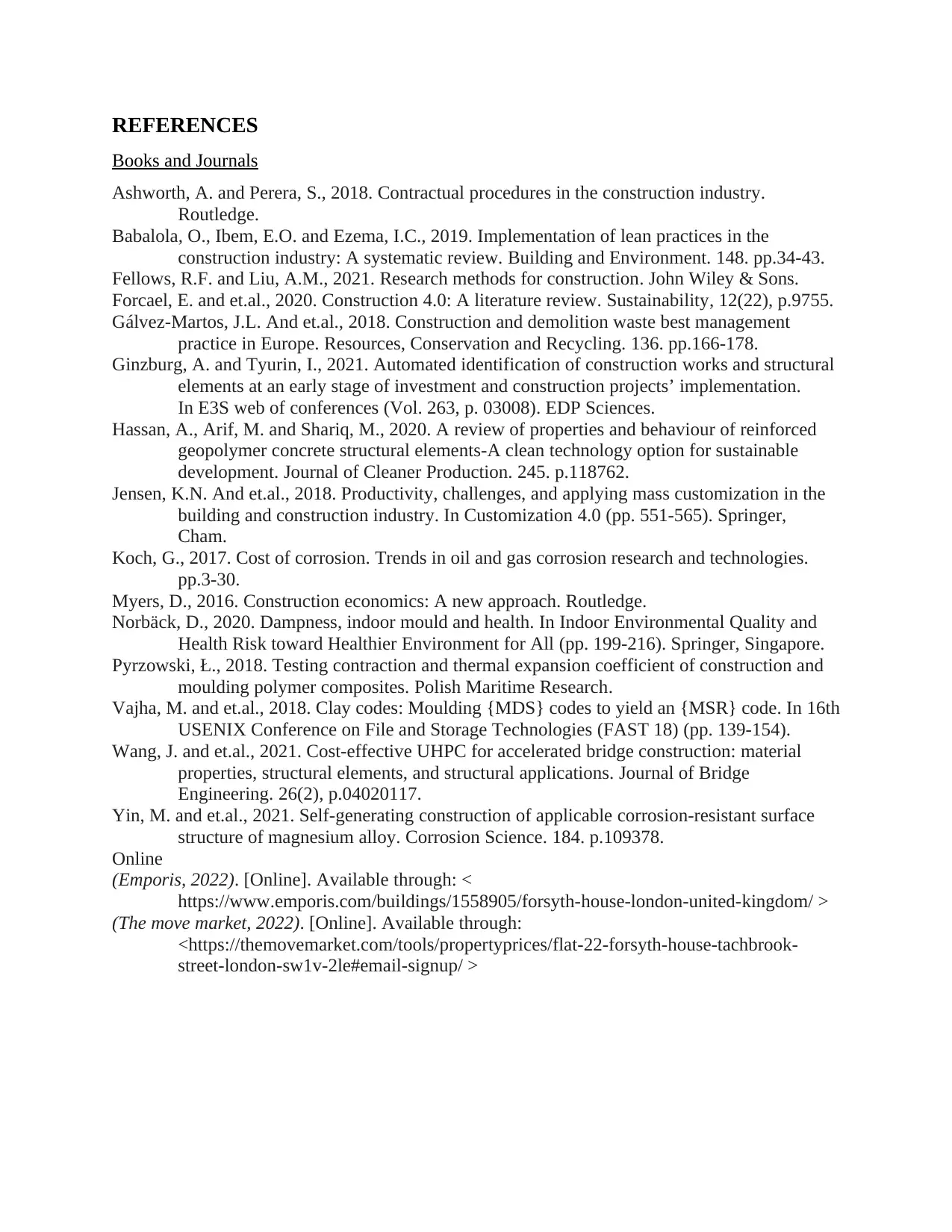
REFERENCES
Books and Journals
Ashworth, A. and Perera, S., 2018. Contractual procedures in the construction industry.
Routledge.
Babalola, O., Ibem, E.O. and Ezema, I.C., 2019. Implementation of lean practices in the
construction industry: A systematic review. Building and Environment. 148. pp.34-43.
Fellows, R.F. and Liu, A.M., 2021. Research methods for construction. John Wiley & Sons.
Forcael, E. and et.al., 2020. Construction 4.0: A literature review. Sustainability, 12(22), p.9755.
Gálvez-Martos, J.L. And et.al., 2018. Construction and demolition waste best management
practice in Europe. Resources, Conservation and Recycling. 136. pp.166-178.
Ginzburg, A. and Tyurin, I., 2021. Automated identification of construction works and structural
elements at an early stage of investment and construction projects’ implementation.
In E3S web of conferences (Vol. 263, p. 03008). EDP Sciences.
Hassan, A., Arif, M. and Shariq, M., 2020. A review of properties and behaviour of reinforced
geopolymer concrete structural elements-A clean technology option for sustainable
development. Journal of Cleaner Production. 245. p.118762.
Jensen, K.N. And et.al., 2018. Productivity, challenges, and applying mass customization in the
building and construction industry. In Customization 4.0 (pp. 551-565). Springer,
Cham.
Koch, G., 2017. Cost of corrosion. Trends in oil and gas corrosion research and technologies.
pp.3-30.
Myers, D., 2016. Construction economics: A new approach. Routledge.
Norbäck, D., 2020. Dampness, indoor mould and health. In Indoor Environmental Quality and
Health Risk toward Healthier Environment for All (pp. 199-216). Springer, Singapore.
Pyrzowski, Ł., 2018. Testing contraction and thermal expansion coefficient of construction and
moulding polymer composites. Polish Maritime Research.
Vajha, M. and et.al., 2018. Clay codes: Moulding {MDS} codes to yield an {MSR} code. In 16th
USENIX Conference on File and Storage Technologies (FAST 18) (pp. 139-154).
Wang, J. and et.al., 2021. Cost-effective UHPC for accelerated bridge construction: material
properties, structural elements, and structural applications. Journal of Bridge
Engineering. 26(2), p.04020117.
Yin, M. and et.al., 2021. Self-generating construction of applicable corrosion-resistant surface
structure of magnesium alloy. Corrosion Science. 184. p.109378.
Online
(Emporis, 2022). [Online]. Available through: <
https://www.emporis.com/buildings/1558905/forsyth-house-london-united-kingdom/ >
(The move market, 2022). [Online]. Available through:
<https://themovemarket.com/tools/propertyprices/flat-22-forsyth-house-tachbrook-
street-london-sw1v-2le#email-signup/ >
Books and Journals
Ashworth, A. and Perera, S., 2018. Contractual procedures in the construction industry.
Routledge.
Babalola, O., Ibem, E.O. and Ezema, I.C., 2019. Implementation of lean practices in the
construction industry: A systematic review. Building and Environment. 148. pp.34-43.
Fellows, R.F. and Liu, A.M., 2021. Research methods for construction. John Wiley & Sons.
Forcael, E. and et.al., 2020. Construction 4.0: A literature review. Sustainability, 12(22), p.9755.
Gálvez-Martos, J.L. And et.al., 2018. Construction and demolition waste best management
practice in Europe. Resources, Conservation and Recycling. 136. pp.166-178.
Ginzburg, A. and Tyurin, I., 2021. Automated identification of construction works and structural
elements at an early stage of investment and construction projects’ implementation.
In E3S web of conferences (Vol. 263, p. 03008). EDP Sciences.
Hassan, A., Arif, M. and Shariq, M., 2020. A review of properties and behaviour of reinforced
geopolymer concrete structural elements-A clean technology option for sustainable
development. Journal of Cleaner Production. 245. p.118762.
Jensen, K.N. And et.al., 2018. Productivity, challenges, and applying mass customization in the
building and construction industry. In Customization 4.0 (pp. 551-565). Springer,
Cham.
Koch, G., 2017. Cost of corrosion. Trends in oil and gas corrosion research and technologies.
pp.3-30.
Myers, D., 2016. Construction economics: A new approach. Routledge.
Norbäck, D., 2020. Dampness, indoor mould and health. In Indoor Environmental Quality and
Health Risk toward Healthier Environment for All (pp. 199-216). Springer, Singapore.
Pyrzowski, Ł., 2018. Testing contraction and thermal expansion coefficient of construction and
moulding polymer composites. Polish Maritime Research.
Vajha, M. and et.al., 2018. Clay codes: Moulding {MDS} codes to yield an {MSR} code. In 16th
USENIX Conference on File and Storage Technologies (FAST 18) (pp. 139-154).
Wang, J. and et.al., 2021. Cost-effective UHPC for accelerated bridge construction: material
properties, structural elements, and structural applications. Journal of Bridge
Engineering. 26(2), p.04020117.
Yin, M. and et.al., 2021. Self-generating construction of applicable corrosion-resistant surface
structure of magnesium alloy. Corrosion Science. 184. p.109378.
Online
(Emporis, 2022). [Online]. Available through: <
https://www.emporis.com/buildings/1558905/forsyth-house-london-united-kingdom/ >
(The move market, 2022). [Online]. Available through:
<https://themovemarket.com/tools/propertyprices/flat-22-forsyth-house-tachbrook-
street-london-sw1v-2le#email-signup/ >
⊘ This is a preview!⊘
Do you want full access?
Subscribe today to unlock all pages.

Trusted by 1+ million students worldwide
1 out of 12
Related Documents
Your All-in-One AI-Powered Toolkit for Academic Success.
+13062052269
info@desklib.com
Available 24*7 on WhatsApp / Email
![[object Object]](/_next/static/media/star-bottom.7253800d.svg)
Unlock your academic potential
Copyright © 2020–2025 A2Z Services. All Rights Reserved. Developed and managed by ZUCOL.





